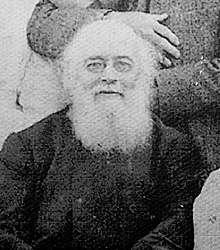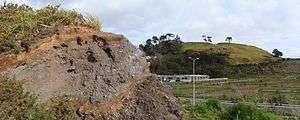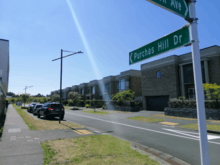Arthur Guyon Purchas
Reverend Dr Arthur Guyon Purchas (27 September 1821 – 28 May 1906) was a clergyman, missionary, surgeon, musician, engineer, inventor, pioneer, geologist and botanist born in Wye Valley, who lived most of his life in Auckland, New Zealand.[1][2][3][4] He was the father of fourteen children and an important figure during British colonisation of New Zealand.[5]
Reverend Dr Arthur Guyon Purchas | |
|---|---|
 Arthur Guyon Purchas in 1895 | |
| Born | 27 September 1821 |
| Died | 28 May 1906 (aged 84) Hastings, Hawke's Bay, New Zealand |
| Burial place | Purewa Cemetry, Meadowbank, Auckland, New Zealand 36.872888°S 174.831364°E |
| Other names | Rata Patiti |
| Occupation | Clergyman, missionary, surgeon, musician, engineer, inventor, pioneer, geologist and botanist |
| Relatives | Albert Purchas (brother) Guyon Purchas (nephew) |
Early life
Purchas was born in Wye Valley, Monmouthshire, Wales on 27 September 1821.
In 1836, he was apprenticed to a doctor. He began studying at Guy's Hospital, London, England in 1839 under doctors Addison and Bright, gaining his M.R.C.S. and L.S.A. after three years on 29 September 1842. He was subsequently appointed resident surgeon at Southern and Toxteth Hospital, Liverpool. While studying, Purchas heard about possible missionary work in New Zealand from Bishop George Selwyn.[1][5]
Emigration to New Zealand
In October 1844, Purchas travelled to New Zealand on the Slains Castle, where he was the surgeon. He arrived in Nelson on 26 January 1845, where he met Bishop Selwyn. He travelled to several parts of New Zealand, including Nelson, Wellington, New Plymouth and Auckland, before returning to England. On 27 December 1845, he married Olivia Purchas (née Challinor) in Liverpool.[1]
In April 1846 Purchas permanently migrated to New Zealand with his wife Olivia Purchas, visiting Sydney, Australia on their way. They departed from Sydney to Auckland on 3 October 1846.[6][7] He learnt to speak and write the Māori language fluently[8][9] and continued work as a doctor and a missionary. He was inducted vicar of St Peter's Church in Onehunga and ordained deacon on 19 September 1847, and later priest on 18 December 1853.[1][4] In 1848, he met and helped introduce future British Prime Minister Robert Gascoyne-Cecil to New Zealand.[4]
In 1850, Purchas became the first European to discover the Huntly coalfields.[4]
Purchas was known for his interest in relations between the British and Māori, seeing education as a priority for the Māori.[6]
In March 1861, Purchas and James Ninnis were granted the first patent in New Zealand history (lodged 10 October 1860).[4] It was for a plant fibre dressing process and leaf-stripping machine for their flax mill on the Waitangi Stream at Waiuku.[8][10] This was accompanied with the enactment of the Purchas and Ninnis Flax Patent Act 1860.[11][12]
Purchas' interest in science saw him work with geologist and botanist Ferdinand von Hochstetter. Together they surveyed the Auckland volcanic field.[4]
Later life
Purchas was the musical director for the New Zealand Anglican Diocese, leading him to produce two national hymnals in both English and Māori. He also taught singing to children at St John's College in Auckland.[13] In addition, he taught music to the blind and invented a system of reading music for the blind; a quick method for preparing metal plates to print braille.[8][9]
Purchas designed the initial Mangere Bridge, which opened in January 1875.[2][9]
He recommenced medical practise as a doctor in 1875.[8] In 1884, Purchas had a block (444–472) built on Karangahape Road, Auckland, designed by Edward Bartley.
Death and legacy


Purchas died on 28 May 1906. He was buried at Purewa Cemetry in Meadowbank, Auckland, on 1 June 1906.[14] In a tribute, the New Zealand Herald stated that "he laid the foundations of all that is good and true in the social life of the colony" with respect to the British colony in New Zealand.[1][15] He has also been described as the 'Leonardo da Vinci of New Zealand',[16] and 'perhaps the most gifted person ever to come to this country [New Zealand]'.[4]
Purchas Hill in Stonefields, Auckland was named after Purchas in gratitude for his work on the Auckland volcanic field by von Hochstetter. The road Purchas Hill Drive is located where Purchas Hill was before being quarried.
The snail Omphalorissa purchasi, discovered by Purchas and Ferdinand von Hochstetter, was named in his honour. The scale insect Icerya purchasi (cottony cushion scale) was originally described in 1878 from specimens collected in New Zealand by Purchas. It was therefore named after him.[17]
References
- Knight, Cyril Roy (1966). "Purchas, Arthur Guyon". In McLintock, A. H. (ed.). An Encyclopaedia of New Zealand. Retrieved 10 October 2019 – via Te Ara – the Encyclopedia of New Zealand.
- Lawlor, Ian. "2009_07_21 - Ian Lawlor (Lost Villages of Manukau MHS Presentation)". Lost Villages of Manukau (Presentation).
- "No Ordinary Man: The Extraordinary Life and Times of Dr Arthur Purchas". Aotearoa Books | Academy Book Company. Retrieved 10 October 2019.
- Steele, John (2019). No Ordinary Man - The extraordinary life and times of Dr Arthur Purchas. Mangawhai, New Zealand: David Ling Publishing Limited. pp. 63, 67, 73, 89, 109, blurb. ISBN 9781927305584.
- "Arthur Guyon Purchas (1821–1906) | WikiTree FREE Family Tree". www.wikitree.com. Retrieved 7 May 2019.
- Lush, Vicesimus (1971). "The Auckland Journals of Vicesimus Lush, 1850-63 - APPENDIX". pp. 261–273. Retrieved 9 October 2019 – via Early New Zealand Books.
- "Arrivals and Departures to and from Sydney during 1846 from and to NZ Ports". freepages.rootsweb.com. Retrieved 9 November 2019.
- "Designing the Future – Celebrating the Past". www.wipo.int. Retrieved 9 October 2019.
- Hill, Julie (20 February 2016). "Dark Side of the Rori". Noted. Retrieved 9 October 2019.
- Parliamentary Debates. New Zealand Parliament House of Representatives. 1886 – via Google Books.
- Taonga, New Zealand Ministry for Culture and Heritage Te Manatu. "Patents in New Zealand". teara.govt.nz. Retrieved 29 April 2020.
- "Purchas and Ninnis Flax Patent Act 1860 (24 Victoriae 1860 No 2)". www.nzlii.org. Retrieved 29 April 2020.
- McLean, Mervyn (1996). Maori Music. Auckland University Press. ISBN 9781869401443.
- "Burial details of Rev A G Purchas". www.wikitree.com. Retrieved 31 May 2019.
- Roche, Edward H; Beattie, Ian David (1993). Ever ready, the life of Arthur Guyon Purchas. Auckland, New Zealand: St. Peter's Church.
- Grant, Jeanette (1 January 2018). "The Rev Dr Arthur Guyon Purchas / by Jeanette Grant". Prospect (Auckland, N.Z.), 2018; v.17:p.42-53; issn. Retrieved 10 October 2019.
- "cottony cushion scale - Icerya purchasi Maskell". entnemdept.ifas.ufl.edu. Retrieved 11 October 2019.